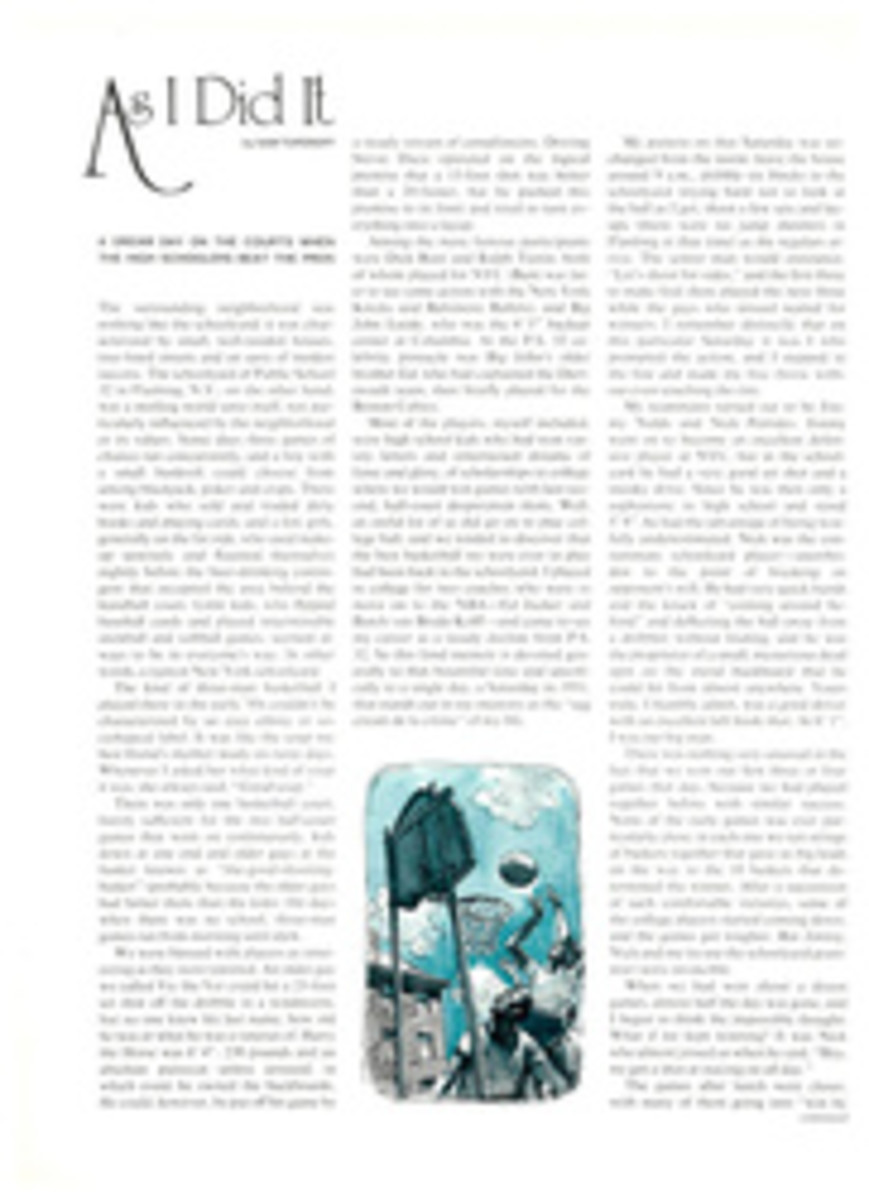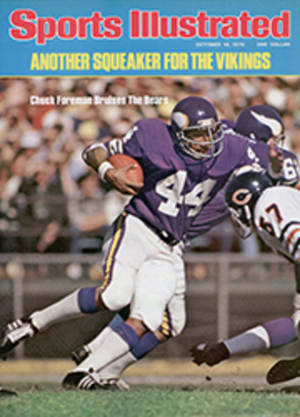
A DREAM DAY ON THE COURTS WHEN THE HIGH SCHOOLERS BEAT THE PROS
The surrounding neighborhood was nothing like the schoolyard: it was characterized by small, well-tended houses, tree-lined streets and an aura of modest success. The schoolyard of Public School 32 in Flushing, N.Y., on the other hand, was a moiling world unto itself, not particularly influenced by the neighborhood or its values. Some days three games of chance ran concurrently, and a boy with a small bankroll could choose from among blackjack, poker and craps. There were kids who sold and traded dirty books and playing cards, and a few girls, generally on the fat side, who used makeup unwisely and flaunted themselves nightly before the beer-drinking contingent that occupied the area behind the handball court. Little kids, who flipped baseball cards and played interminable stickball and softball games, seemed always to be in everyone's way. In other words, a typical New York schoolyard.
The kind of three-man basketball I played there in the early '50s couldn't be characterized by an easy ethnic or sociological label. It was like the soup my best friend's mother made on rainy days. Whenever I asked her what kind of soup it was, she always said, "Good soup."
There was only one basketball court, barely sufficient for the two half-court games that went on continuously, kids down at one end and older guys at the basket known as "the-good-shooting-basket" (probably because the older guys had better shots than the kids). On days when there was no school, three-man games ran from morning until dark.
We were blessed with players as interesting as they were talented. An older guy we called Vic the Vet could hit a 25-foot set shot off the dribble in a windstorm, but no one knew his last name, how old he was or what he was a veteran of. Harry the Horse was 6'4", 230 pounds and an absolute pussycat unless aroused, in which event he owned the backboards. He could, however, be put off his game by a steady stream of compliments. Driving Stevie Duca operated on the logical premise that a 15-foot shot was better than a 20-footer, but he pushed this premise to its limit and tried to turn everything into a layup.
Among the more famous participants were Dick Bunt and Ralph Tustin, both of whom played for NYU (Bunt was later to see some action with the New York Knicks and Baltimore Bullets), and Big John Leede, who was the 6'5" backup center at Columbia. At the P.S. 32 celebrity pinnacle was Big John's older brother Ed. who had captained the Dartmouth team, then briefly played for the Boston Celtics.
Most of the players, myself included, were high school kids who had won varsity letters and entertained dreams of fame and glory, of scholarships to college where we would win games with last-second, half-court desperation shots. Well, an awful lot of us did go on to play college ball, and we tended to discover that the best basketball we were ever to play had been back in the schoolyard. I played in college for two coaches who were to move on to the NBA—Ed Jucker and Butch van Breda Kolff—and came to see my career as a steady decline from P.S. 32. So this fond memoir is devoted generally to that bountiful time and specifically to a single day. a Saturday in 1951, that stands out in my memory as the "egg cream de la cr√®me" of my life.
My pattern on that Saturday was unchanged from the norm: leave the house around 9 a.m., dribble six blocks to the schoolyard (trying hard not to look at the ball as I go), shoot a few sets and lay-ups (there were no jump shooters in Flushing at that time) as the regulars arrive. The senior man would announce. "Let's shoot for sides." and the first three to make foul shots played the next three while the guys who missed waited for winners. I remember distinctly that on this particular Saturday it was I who prompted the action, and I stepped to the line and made my free throw without even touching the rim.
My teammates turned out to be Jimmy Nidds and Nick Petrides. Jimmy went on to become an excellent defensive player at NYU, but in the schoolyard he had a very good set shot and a sneaky drive. Since he was then only a sophomore in high school and stood 5'8", he had the advantage of being woefully underestimated. Nick was the consummate schoolyard player—unorthodox to the point of breaking an opponent's will. He had very quick hands and the knack of "coming around behind" and deflecting the ball away from a dribbler without fouling, and he was the proprietor of a small, mysterious dead spot on the metal backboard that he could hit from almost anywhere. Yours truly, I humbly admit, was a good driver with an excellent left hook shot. At 6'1". I was our big man.
There was nothing very unusual in the fact that we won our first three or four games that day, because we had played together before with similar success. None of the early games was ever particularly close; in each one we ran strings of baskets together that gave us big leads on the way to the 10 baskets that determined the winner. After a succession of such comfortable victories, some of the college players started coming down, and the games got tougher. But Jimmy, Nick and me (to use the schoolyard grammar) were invincible.
When we had won about a dozen games, almost half the day was gone, and I began to think the impossible thought: What if we kept winning? It was Nick who almost jinxed us when he said, "Hey, we got a shot at staying on all day."
The games after lunch were closer, with many of them going into "win by two"; this was our overtime and simply meant that the first team to go ahead by two baskets was the winner. The most memorable game went to 23-22, our favor, before Nick threw one off his ear toward his spot on the backboard. That spot (it couldn't have been larger than Dolph Schayes' pinky) was Nick's philosopher's stone: it transformed the basest shot into pure gold. There was a palpable sigh when the ball fell through the basket.
And so it went until late afternoon. It was glorious. Then the big guns, Ralph Tustin, Dick Bunt, Big John Leede, arrived, but we had become transcendent—Mosconi clearing a table, Maglie working on a hitter. Whatever the opposition's strong point, we found a way to beat it, much to the anger of our opponents and the glee of the kids rooting for us.
The biggest threat, Ed Leede, arrived around twilight looking like a successful gunfighter, and he brought his Celtic teammate Joe Mullaney with him. The yard was buzzing with the recognition of celebrity. Showing the very best schoolyard manners, the pros waited two games for their turn and picked Big John as a third when they came on the court. They warmed up casually, confidently, while Jimmy and Nick and me sat at half court, watched and made plans. When the game started, it turned out that no one could play Nick, and Jimmy almost shut out Ed Leede. Both Celtics were off in their shooting. We won easily.
At the rate of four victories an hour—a conservative estimate—we had won between 45 and 50 consecutive games. Then when darkness threatened to put an end to our skein, a plan was devised to put our success to the supreme test. Some of the older guys drove their cars into the schoolyard and lit up the court with their headlights. (The craps shooters thought it was a raid and scattered while their dice were still tumbling.)
The championship game pitted us in a rematch with the two Celtics and Big John. Although it might be more dramatic to recount a titanic battle that lasted until midnight, the truth is that we beat them as easily as the first time, and there were handshakes and congratulations all around. Then one by one the cars slipped away, and most of the spectators disappeared. I remember a kid offered to carry my ball home. Jimmy was late for supper and ran off saying, "See you guys tomorrow." Nick invited me to his father's restaurant for a hero sandwich, but I wanted to be alone. I think I knew even then this was my greatest day in the schoolyard and, in some way, the highlight of my life.
In the darkened corners of the yard the gamblers were operating around small candles and the naughty girls were being whisked off to the school's vestigial Victory Garden as I started to dribble home. I dribbled all the way without looking at the ball once, or bothering to touch the ground as mortals do.
ILLUSTRATION

